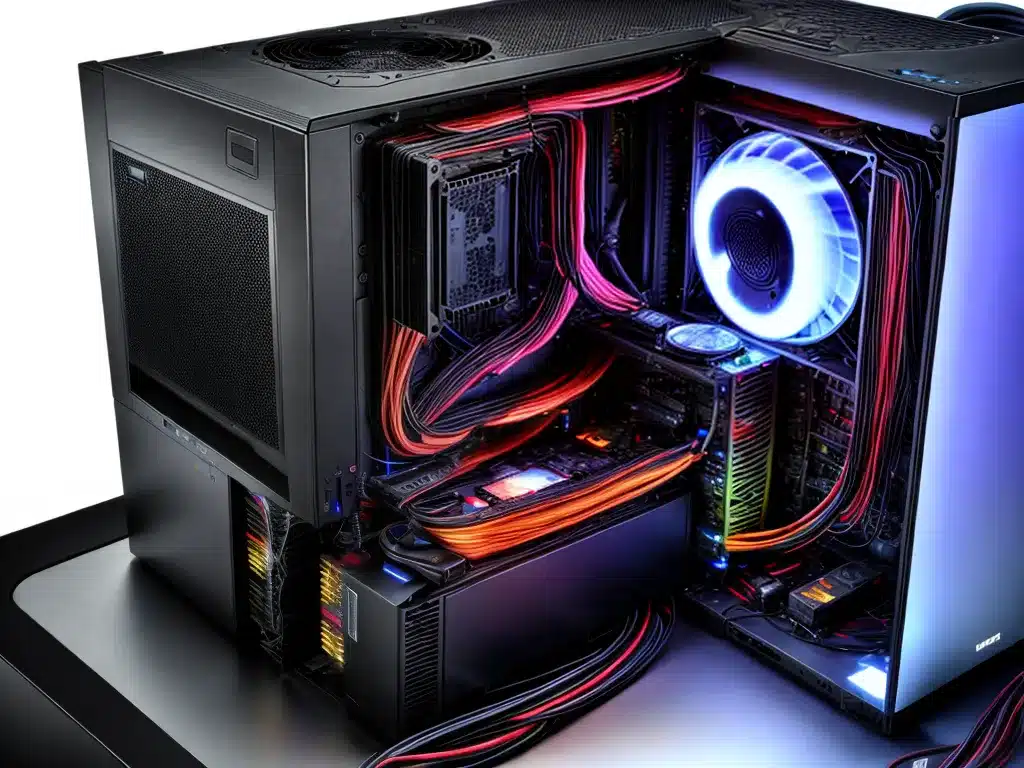
Overheating is a common issue that can affect desktop PCs. High temperatures can lead to system instability, reduced performance, and hardware damage if left unchecked. Fortunately, there are several troubleshooting steps you can take to diagnose and fix overheating problems.
Causes of Overheating
There are a few key components in a desktop PC that can overheat and cause issues:
CPU
The CPU (central processing unit) is designed to generate some heat, but excessive temperatures can cause it to throttle performance or shut down to prevent damage. Common causes are:
-
Insufficient cooling – Using the stock CPU cooler that came with your processor may not be enough, especially if you have overclocked your CPU or use resource-intensive applications. An aftermarket CPU cooler with larger heatsinks and fans can improve cooling capacity.
-
Thermal paste issues – The thermal paste between the CPU and cooler can dry out or become displaced. Replacing the paste can restore proper heat transfer.
-
Dust buildup – Dust accumulation on the CPU cooler fins and fans reduces airflow and cooling efficiency. Regular cleaning is essential.
GPU
The graphics card is another component that produces significant heat under load. Problems include:
-
Insufficient airflow – GPU fans and heatsinks need sufficient airflow to work properly. Restricted intake/exhaust vents or a crowded PC case can lead to heat buildup.
-
Fan failures – GPU fans wear out over time. Replacing broken or noisy fans improves cooling.
-
Dust buildup – Just like the CPU cooler, accumulated dust on the graphics card’s cooler assembly decreases cooling capabilities.
Power Supply
An overtaxed or failing PSU (power supply unit) can also produce excess heat. Warning signs include:
-
Overpowered components – Using a PSU with insufficient wattage capacity for your hardware places extra load on the unit.
-
Poor ventilation – Power supplies require open space around them for ventilation. Keep the PSU area clear.
-
Old age – PSU efficiency and fan function decline over time. Replace an older PSU if overheating occurs.
Inadequate Case Cooling
If the overall airflow and ventilation in the case is poor, components can recirculate hot air instead of expelling it from the chassis. Consider adding more case fans or assessing fan placement.
Diagnosing Overheating Issues
Detecting overheating problems involves both software monitoring and physical inspections.
Monitor temperatures
Use system utility software like Speccy or Open Hardware Monitor to check current CPU, GPU, and system temperatures. Consistently high readings above 90-100°C indicate an overheating component.
Compare temperatures at idle versus under heavy load – thermal throttling is likely if you see a dramatic spike in temps when gaming or running intensive applications.
Check for stability issues
System crashes, blue screens, unexpected reboots, and performance throttling can signify overheating hardware.
Games and 3D apps that trigger shutdowns likely indicate a graphics card issue. System-wide instability points to CPU or overall case cooling problems.
Physically inspect components
Visually check fans, heatsinks, and vents for dust buildup that can restrict airflow.
Feel along heatsink pipes and the backplate of hot components to check for excessive heat. A hot surface indicates cooling deficiencies.
Listen and check for noisy, grinding, or stalled fans that need replacement.
Fixing Overheating Problems
Try these troubleshooting steps based on your observations:
1. Clean components
Use compressed air to clear dust from CPU and GPU heatsinks, case vents, intake filters, and case fans. Replace any fans that aren’t spinning properly. This basic step improves airflow and cooling efficiency.
2. Reapply thermal paste
If temperatures remain high, remove the CPU cooler, scrape off old paste, and reapply quality thermal paste for optimal heat transfer from the CPU die. Spread thinly and evenly across the processor.
3. Upgrade cooling solutions
Consider a larger air cooler, all-in-one liquid cooler, or additional case fans if your current cooling is inadequate. This may require extra fan mounts or a larger PC case.
4. Improve case airflow
Evaluate fan placement and direction – you generally want front intakes and rear/top exhausts. Remove any airflow obstructions inside the case. Adding intake/exhaust fans can improve ventilation.
5. Lower ambient temperatures
Ensure your PC case has space for ventilation and isn’t crammed in an enclosed space. Room and ambient temperatures directly affect your components. Try moving your PC to a cooler spot or running an air conditioner.
6. Replace faulty hardware
If fixes don’t lower temperatures significantly, the CPU, GPU, power supply, or other components may need replacement due to malfunction or age-related failure.
Preventing Overheating Issues
Follow these tips to help prevent overheating problems:
- Use quality thermal paste and properly attach CPU coolers
- Maintain cleanliness inside your case
- Ensure unrestricted airflow to components
- Use an appropriately sized power supply
- Don’t overclock components excessively
- Monitor temps with utility software
- Replace aging fans and thermal paste regularly
Keeping your desktop PC components cool will prevent crashes, extend hardware lifespan, and deliver optimal gaming performance. Let me know if you have any other overheating questions!












